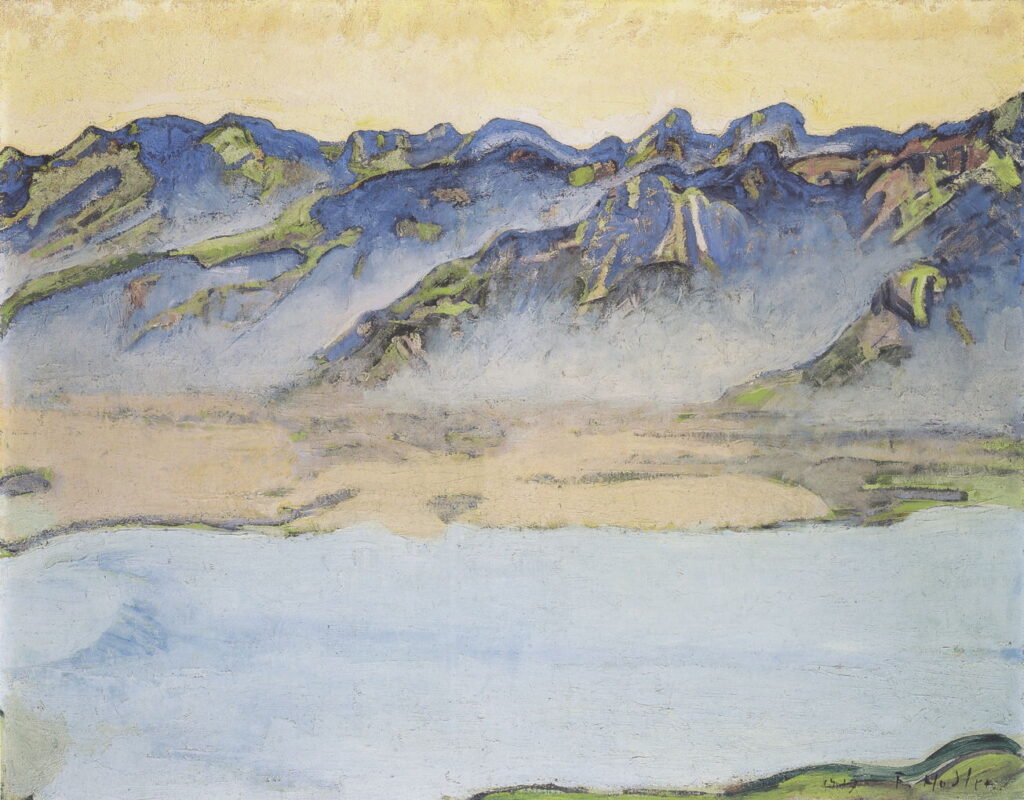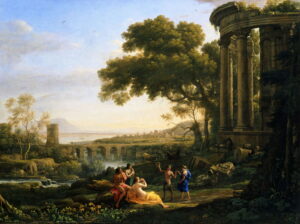Rising fog in paintings 2

The nineteenth century saw a change in the attitude of landscape painters to fog, thanks to pioneering views by Caspar David Friedrich and JMW Turner in the early years of the century. By its last decade, fog had become a favourite compositional tool of the French Impressionists.
Camille Pissarro (1830-1903), Setting Sun and Fog, Éragny (1891), oil on canvas, 54 x 65 cm, Private collection. WikiArt.
In 1891, before he returned to mainstream Impressionism, Camille Pissarro painted this bank of dense fog at the edge of a wood, in his Setting Sun and Fog, Éragny. The play of the fog on the cattle here demonstrates how objects viewed through fog can be transformed to look unfamiliar, mysterious, even ghostly.
Pierre-Georges Jeanniot (1848–1934), Night on the Seine (1892), further details not known. Wikimedia Commons.
Pierre-Georges Jeanniot’s Night on the Seine of 1892 is unusual, being a nocturne modulated by fog. It shows the river running through central Paris on a slightly foggy night, and plays skilfully with effects on lights, and their reflections, as well as being thoroughly painterly. Jeanniot also demonstrates the contrasting opacity of smoke.
Claude Monet (1840–1926), The Houses of Parliament, Sunlight Effect (1903), oil on canvas, 81.3 × 92.1 cm, Brooklyn Museum, New York, NY. Wikimedia Commons.
When Claude Monet returned to London in 1899, and in the following two years, he chose to paint a series of 19 works examining different atmospheric effects on the same view of the Palace of Westminster. These were all started from the second floor of the Administrative Block at the northern end of the old Saint Thomas’s Hospital on the south bank of the River Thames, and completed over the following three or four years. His The Houses of Parliament, Sunlight Effect (1903) is even more radical than his painting of thirty years before, showing little more than the Palace in silhouette, the sun low in the sky, and its broken reflections in the water.
Claude Monet (1840–1926, Waterloo Bridge. Effect of Fog (1903), oil on canvas, 65.3 x 101 cm, Hermitage Museum Государственный Эрмитаж, Saint Petersburg, Russia. Wikimedia Commons.
Monet’s Waterloo Bridge from 1903 is the ultimate conclusion of his paintings of fog, in which only the softest of forms resolve in its pale purple and blue vagueness, his common destination with the paintings of Turner over fifty years before.
Francisco Pradilla Ortiz (1848–1921), Niebla de primavera en Italia (The Fog of Spring in Italy) (1907), oil on canvas, 65.4 × 94.6 cm, location not known. Wikimedia Commons.
Francisco Pradilla Ortiz doesn’t seem to have painted many pure landscapes, but The Fog of Spring in Italy from 1907 was probably inspired by one of his visits there.
Henri Le Sidaner (1862–1939), Fog in the Midi (c 1910), oil on canvas, 73 x 92 cm, Museo de Bellas Artes de Valparaíso, Valparaíso, Chile. Image by Rodrigo Fernández, via Wikimedia Commons.
In about 1910, Henri Le Sidaner followed in the brushstrokes of the Divisionists in his Fog in the Midi.
Félix Vallotton (1865–1925), Honfleur in Fog (1911), oil on canvas, dimensions not known, Musée des Beaux-Arts, Nancy, France. Image by Ji-Elle, via Wikimedia Commons.
Félix Vallotton’s Honfleur in Fog from 1911 is an unconventional view of this small port on the north French coast, as it looks down from Mont-Joli to the west of the town centre. It captures exactly the sort of transient effects that were the concern of Impressionism, but in Vallotton’s distinctive style.
Émile Claus (1849-1924), (Sunset over Waterloo Bridge) (1916), oil on canvas, dimensions not known, location not known. WikiArt.
Others, like Émile Claus in his Sunset over Waterloo Bridge from 1916, were careful to retain as much form as they could. He uses billowing clouds of steam and smoke to great effect, and his inclusion of the road, trees and terraces in the foreground, on the Embankment, provides useful contrast with the crisp arches of the bridge, and the vaguer silhouettes in the distance.
Ferdinand Hodler (1853–1918), Rising Fog Over the Savoy Alps (1917), oil on canvas, 68.5 x 88 cm, Musée d`art et d`histoire, Geneva, Switzerland. Wikimedia Commons.
Easily mistaken for a watercolour, the optical effect in Ferdinand Hodler’s later Rising Fog Over the Savoy Alps, painted in the summer of 1917, heralds his change to extreme simplification, as the valley mist obliterates detail.
Jakub Schikaneder (1855–1924), Riverbank with Tram (date not known), oil on canvas, 95 x 129 cm, location not known. Wikimedia Commons.
Jakub Schikaneder’s undated Riverbank with Tram shows a tram travelling during a damp and foggy autumn evening probably in Prague.
Sir George Clausen (1852–1944), The Road, Winter Morning (1923), oil on canvas, 50.8 x 61.0 cm, The Tate Gallery (Presented by the Trustees of the Chantrey Bequest 1923), London. Photographic Rights © Tate 2016, CC-BY-NC-ND 3.0 (Unported), http://www.tate.org.uk/art/artworks/clausen-the-road-winter-morning-n03824
After the First World War, realist landscape artists such as George Clausen continued to use the optical effects of fog in their paintings. The Road, Winter Morning from 1923 shows Barnard’s Farm at Duton Hill in the flatlands near Dunmow in Essex, England. Its mist and morning sunlight bring more subtle colour, a marked contrast to his earlier Impressionist paintings.
Lesser Ury (1861–1931), London in Fog (1926), oil on canvas, 67 x 97 cm, location not known. Wikimedia Commons.
My last example is another view over the River Thames, this time by Lesser Ury. London in Fog from 1926 doesn’t appear to be a nocturne, but looks at the effects of fog on both lights and their reflections in a different way from Jeanniot’s painting above.
I think that it’s safe to conclude that Western art has finally accepted the virtues of painting in fog, just a few centuries later than Asian painting.



